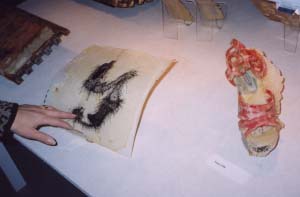ABOVE: Aganetha Dyck, untitled, 2000
Photograph by Peter Dyck
Edited by Serena Keshavjee. The following introduction is by Mark L. Winston.
AGANETHA DYCK Introduction: Science, Art, and Bees
Scientists who study bees lean towards the practical when conducting experiments or managing these productive creatures. We focus on collecting objective data to test hypotheses or making pragmatic decisions about when to extract honey or how to best prepare our colonies for winter.
Because we routinely conduct business with bees, we often overlook the profound lessons they provide in spheres beyond data and commerce. Bees can also yield insights into the spiritual, religious, and philosophical realms for those who pause to listen to their message.
My city of Vancouver has a science museum with a glass-walled observation hive that invariably draws a crowd transfixed by the daily tasks being performed inside the nest. Some observe with a workmanlike demeanor, searching for something defined and specific, perhaps watching the queen laying an egg or following worker bees performing their dances that communicate the location of flowers in nearby gardens.
Other onlookers are in a deeper place, transfixed and absorbed by the milieu of the bees without trying to find anything in particular. These observers appear to be meditating, using senses that go further than sight, sound, and smell to absorb them for a moment into that sublime place that bees occupy outside of the human experience.
Historically, many have gone beyond utility to consider bees as spiritual metaphors. Muslims say that true believers are like bees who have chosen the fairest flowers to visit for nectar, and they consider bees to be angels. The ancient Egyptians believed that bees were born from the tear of the sun god Ra falling to earth, and the Greek philosopher Plato thought bees to be the souls of the righteous who were reincarnated. Christians consider the musical ability and eloquent sermons of Saint Ambrose to come from bees having touched his lips while he was in the cradle, and in Hebrew the terms for “bee” and “speech” derive from the same root.
What is most remarkable about the work of Aganetha Dyck is how she releases the voice of bees to speak with us at the junction of the tangible and the spiritual. She creates a path between the practical perspective that characterizes those who study and work with bees and the empyreal sphere inhabited by these marvellous animals.
Aganetha Dyck connects these realms through her art, consulting with the bees themselves who apply beeswax and build comb on and around the interloping human objects that she has placed into their nests. Her art honours honey bees by evoking their self-produced imagery, yielding unique and complex statements that link the labour of the bees to our human sensibilities.
This is the gift she brings us through her work. We all inhabit different sectors, we humans in ours and the bees in theirs, scientists in the world of the practical and artists in the realm of the barely expressible.
To view her art is to bridge the chasm between species and perspectives, to connect the testable hypotheses of the scientist, the creative ability of the artist, and the underlying wisdom of the hive.
To view her art is to approach the essence of another species, a privilege unlocked through Dyck’s unique vision and the work of her friends and colleagues, the bees.
Mark L. Winston
Department of Biological Sciences
Simon Fraser University
winston@sfu.ca
The Aganetha Dyck: Nature as Language CD-ROM includes essays, images and the interactive work called The Wax Museum which is an Aganetha Dyck, Richard Dyck and William Eakin collaboration. The disk also contains information about other Gallery One One One exhibitions: $20.00 plus shipping = $25.00 payable to Gallery One One One, School of Art, Main Floor, FitzGerald Building, University of Manitoba Fort Garry campus, Winnipeg, MB, CANADA R3T 2N2
TEL:204 474-9322 FAX:474-7605
For information please contact Gallery Coordinator Robert Epp
eppr@ms.umanitoba.ca

